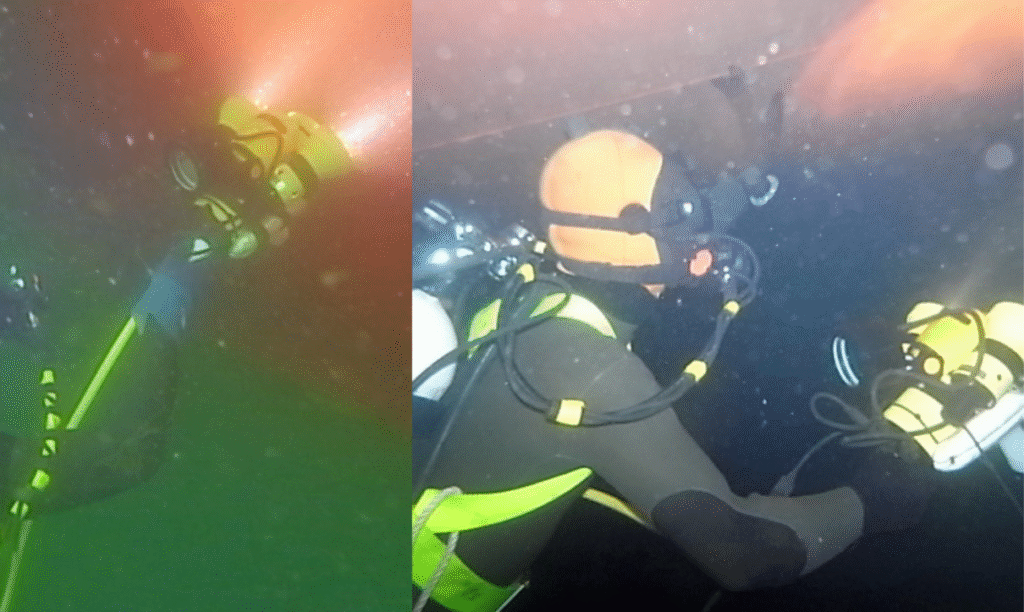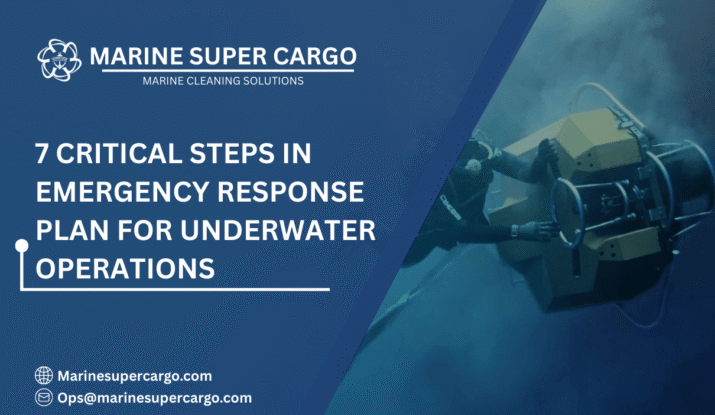When you imagine divers beneath a ship’s hull, scraping away biofouling or inspecting propellers, it may look peaceful—almost routine. But beneath the waterline, every second counts. The ocean is unforgiving, and without an Emergency response plan for underwater operations, unexpected hazards can spiral into life-threatening disasters within moments.
This guide dives deep into what an emergency response plan looks like in real underwater operations—exploring its importance, structure, real-world applications, compliance aspects, and future innovations. Whether you’re a shipowner, operator, or diving supervisor, this is your essential manual for protecting lives, vessels, and the environment.
Why an Emergency Response Plan Matters
Underwater operations are not ordinary jobs—they are high-risk activities carried out in extreme environments. Divers may face entrapment, equipment failure, decompression illness, strong currents, or encounters with pollution. Without an Emergency response plan for underwater operations, these risks can escalate uncontrollably.
Here’s why planning matters:
- Saves lives by enabling timely rescue and medical interventions.
- Reduces costly downtime and liability in accidents.
- Ensures compliance with standards from IMCA, IMO, and MARPOL Convention.
- Builds confidence among divers, crew, clients, and regulators.
- Prevents small incidents from evolving into major disasters.
Think of the plan as a ship’s lifeboat—it is something you hope you’ll never use, but when you need it, nothing else can substitute.

What Is an Emergency Response Plan for Underwater Operations?
In maritime terms, an Emergency response plan for underwater operations is a structured, written procedure designed to handle potential emergencies during diving or hull cleaning. It defines:
- Key risks and scenarios to prepare for.
- Roles and responsibilities of divers, supervisors, and crew.
- Communication protocols for immediate action.
- Equipment and emergency gear needed.
- Medical, evacuation, and rescue steps.
- Compliance with port, IMO, and contractor standards.
It’s not about eliminating emergencies—that’s impossible at sea. Instead, it transforms unpredictability into a script where everyone knows their lines.
🌊✨ Client Testimonial Spotlight ✨🌊
— Marine Super Cargo (@Marinsupercargo) September 16, 2025
💬 “The team at Marine Super Cargo feels like part of our crew. From hold cleaning to supercargo support, they handle everything seamlessly. Their quick response and reliable service saved us valuable time and money.” – Mr. Ingmar Domrös pic.twitter.com/bPlooKOakt
Core Principles of a Strong Plan
A reliable Emergency response plan for underwater operations rests on essential principles:
- Preparedness: All teams are trained and familiar with scenarios.
- Clear Communication: Redundancy in systems—radios, rope signals, hand gestures.
- Role Clarity: Each person has defined duties in an emergency.
- Redundancy: Backup safety diver, spare equipment, oxygen, and medical tools.
- Continuous Review: Plans are updated regularly and drilled.
These principles turn chaos into controlled action under stress.
Key Hazards in Underwater Operations
Before creating the plan, it helps to understand common risks:
- Decompression Illness (also called “the bends”).
- Equipment Failure (regulators, helmets, compressors, hoses).
- Loss of Communication between the diver and the surface crew.
- Entrapment around fouling, propellers, or confined spaces.
- Pollution Hazards like oils, chemicals, or sewage (MARPOL-relevant).
- Strong Currents or Low Visibility can cause disorientation or collisions.
Each risk requires specific, rehearsed response measures.
Steps to Build an Emergency Response Plan
To ensure your Emergency response plan for underwater operations is practical, build it with these structured steps:
1. Risk Assessment
Identify potential accidents and rate them by severity and likelihood. Align findings with IMCA Guidelines.
2. Pre-Dive Preparedness
- Medical checks of divers.
- Inspection of all life-support equipment.
- Confirmation that standby divers are ready.
3. Communication Setup
Establish redundant voice and visual systems between crew and divers.
4. Rescue and Evacuation Plan
Designate rescue teams, prepare evacuation procedures to surface vessels or decompression chambers, and connect with local emergency services.
5. Medical Support
Maintain oxygen, first-aid kits, and decompression facilities. Pre-identify the nearest hyperbaric treatment center.
6. Environmental Controls
Ensure fouling debris is collected and disposed of per MARPOL Convention, preventing double-risk scenarios involving pollution.
7. Training and Drills
Regularly rehearse scenarios so responses become second nature.
Crew and Diver Roles in Emergencies
The most effective emergency response plans rely on teamwork:
- Diving Supervisor: Command center, coordinating divers and surface team.
- Standby Diver: Immediate rescuer for entrapments or failures.
- Deck Crew: Manage air supplies, lifelines, and lookout duties.
- Vessel Master: Ensures vessel stability, stops machinery, and liaises with port authorities.
- Safety Officer: Evaluates hazards, halts unsafe tasks, and maintains compliance.
Everyone’s role is defined before the dive begins, leaving no ambiguity during critical moments. Also read about underwater hull cleaning in Australia.
Compliance, Legal, and Audit Perspectives
Maritime law expects operators to minimize risks through structured systems. The Emergency response plan for underwater operations helps operators comply with:
- IMO Safety Conventions covering crew and diver safety.
- IMCA Guidelines for diving operations.
- MARPOL Convention to prevent marine pollution during hull cleaning and fouling removal.
- IAPH Guidance for safe work in ports.
Having documented plans also reduces liability and builds confidence with marine insurers.
Real-World Example: When a Plan Saved Lives
In one hull-cleaning job, divers working under low visibility conditions lost communication with the surface. According to the Emergency response plan for underwater operations, the standby diver was immediately dispatched, lines were checked, and the silent diver was located within minutes. Investigation showed a faulty comms line, but because the plan worked, disaster was avoided.
This is proof: a plan isn’t theory—it is survival made systematic. Learn more
Innovations in Emergency Response
The future is making plans smarter:
- AI-based Analytics: Predicting risks based on tide, current, and weather data.
- Digital Incident Logs: Real-time entries accessible by ship, port, and diving teams.
- Wearable Monitors: Tracking diver vitals, sending alerts to surface crews.
- Drone & ROV Assistance: Locating missing divers or assessing hazards quickly.
- Green-Safety Links: Responding to ecological hazards alongside diver emergencies in line with MARPOL.
Such innovations will make the future Emergency response plan for underwater operations proactive, not just reactive.

Practical Guidance for Shipowners and Operators
- Never treat plans as paperwork—they are living tools.
- Involve both divers and crew in training.
- Audit and revise emergency drills annually.
- Build redundancy into every rescue element.
- Partner with authorities and maintain hospital contacts in all ports.
Preparedness may cost time, but unpreparedness costs lives and reputation.
Conclusion
An Emergency response plan for underwater operations is your frontline defense against the unforgiving sea. The three key takeaways are:
- Plans protect divers from inevitable hazards through structured preparedness.
- Crew coordination is the backbone of effective rescue.
- Compliance with IMCA, IMO, and MARPOL safeguards both life and the environment.
For shipowners serious about sustainable and safe underwater work, turning to professionals such as CleanShip.co ensures that safety is never compromised.
FAQs:
Q1. Why is an Emergency response plan for underwater operations important?
Because hazards like decompression illness, entrapments, and pollution risks need documented procedures and rehearsed responses.
Q2. Who is responsible for implementing underwater emergency plans?
The diving supervisor, vessel master, and safety officer share responsibility, supported by divers and crew.
Q3. How does compliance help in emergencies?
It ensures international standards (IMO, IMCA, MARPOL) are met, reducing risks, liabilities, and delays during rescue efforts.
Q4. How often should emergency drills be done?
At least annually, with refreshers whenever new crew join or conditions change. Practicing ensures smooth execution in real events.
Q5. Can technology improve underwater emergency responses?
Yes—AI monitoring, biometric sensors, ROVs, and digital permits strengthen safety, speed, and precision in modern plans.


